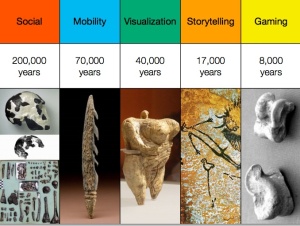Yesterday afternoon in the studio, I ran the concept of my upcoming NCECA presentation (search my name, I’m actually in the program, mildly terrifying) by two students, Brian and Drew. Both students have taken Ceramics I & II, so they have had the equivalent of one school year in the studio; Drew is currently enrolled in Ceramics III. As we started to talk, I realized that this conversation may have some topics I’d like to revisit later – so I asked if I could record. They are both troopers, and so they agreed.
Here’s that recording. I like the hum of the wheel in the background. I edited out a few of the longer pauses and one point when we all started laughing. It’s a little long, but worth a listen –
The driving questions of the upcoming presentation have to do with whether, how, and/or how best to integrate technology into a ceramics classroom. It’s unfair to summarize a lot of complex insights, but it generally seemed that Brian and Drew were not much in favor of using technology in the introductory level of a hands-on course. Learning about new techniques, ideas, and artists via technology seems valid to my students – especially insofar as the opportunity to branch out beyond the teacher’s expertise. But, at the introductory level, they see the teacher as being the primary motivator.
I asked, at one point, whether ceramics ‘should’ be a break from the heavy emphasis on technology integration that students are facing in a lot of classes. Leading question, obviously, but a different response than I expected. Brian had this to say:
I wouldn’t really call it a break… I come in here and it’s kind of like it’s a different mindset… now it’s like I’m concentrated on working on stuff like this. When I’m in a classroom and I’m learning, I’m listening to the teacher constantly, I’m taking notes, I’m memorizing, but when I’m in here, I’m with myself. You’re the one teaching us, but I’m the one having to concentrate just on my own thoughts. I’m thinking to myself, ‘do this, don’t do that,’ but… in a classroom, we’re just thinking, writing stuff down… but in this room we’re… you’re teaching us…. There’s a point where it comes down to us.
This shift – the “different mindset” when learning becomes self-motivated rather than responsive to and driven by the teacher – doesn’t sound like something exclusive to a hands-on class. It actually sounds a lot like Csikszentmihalyi’s ideas about flow…. or like the ideas that Jane McGonigal proposes about games.
“It is when we act freely, for the sake of the action itself rather than for ulterior motives, that we learn to become more than what we were. When we choose a goal and invest ourselves in it to the limits of concentration, whatever we do will be enjoyable. And once we have tasted this joy, we will redouble our efforts to taste it again. This is the way the self grows.”
-Mihaly Csikszentmihalyi, Flow
“A game is an opportunity to focus our energy, with relentless optimism, at something we’re good at (or getting better at) and enjoy. In other words, gameplay is the direct emotional opposite of depression.”
-McGonigal / Reality Is Broken: Why Games Make Us Better and How They Can Change the World
So – maybe – rather than focusing in on the integration of technology – one way to enhance learning in my classes might be to play a little with this concept of flow / gaming /self-motivation. It sounds like it’s something that my students really value. How can I structure things so that we reach it sooner?
After all, not all 21st century tools are things that plug into the wall. Jared sent me towards learning about the SAMR model – which merits its own post a little later, after I’ve learned more – but featured the image below, which I couldn’t love more. Seems that the concepts we are prioritizing now are nothing so new. The tools are changing, but the value these concepts bring to learning is part of who we are as humans.
—–
As a little postscript on this entry, I’ve been struggling to find a way to organize some of the content of the presentation. Unprompted, Drew chimed this in to the conversation yesterday. Much shorter – less than two minutes:
Add ‘portfolios’ to the mix, and we now have an outline.
I’m so lucky to be able to have conversations like this every day.







